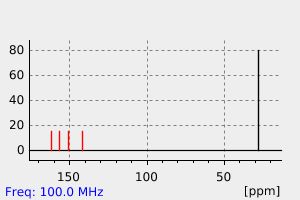2,6-diamino-3-methyl-5-nitrosopyrimidin-4(3H)-one | 31469-63-3
中文名称
——
中文别名
——
英文名称
2,6-diamino-3-methyl-5-nitrosopyrimidin-4(3H)-one
英文别名
2,4-diamino-1-methyl-5-nitroso-6-oxopyrimidine;2,4-diamino-5-nitroso-6-oxo-pyrimidine;2,6-diamino-3-methyl-5-nitroso-3H-pyrimidin-4-one;InChI=1/C5H7N5O2/c1-10-4(11)2(9-12)3(6)8-5(10)7/h6H2,1H3,(H2,7,8;2,6-diamino-3-methyl-5-nitrosopyrimidin-4-one
CAS
31469-63-3
化学式
C5H7N5O2
mdl
——
分子量
169.143
InChiKey
AEANNQKPRCDUBX-UHFFFAOYSA-N
BEILSTEIN
——
EINECS
——
-
物化性质
-
计算性质
-
ADMET
-
安全信息
-
SDS
-
制备方法与用途
-
上下游信息
-
文献信息
-
表征谱图
-
同类化合物
-
相关功能分类
-
相关结构分类
计算性质
-
辛醇/水分配系数(LogP):-1.5
-
重原子数:12
-
可旋转键数:0
-
环数:1.0
-
sp3杂化的碳原子比例:0.2
-
拓扑面积:114
-
氢给体数:2
-
氢受体数:5
上下游信息
-
上游原料
中文名称 英文名称 CAS号 化学式 分子量 —— 6-amino-3,4-dihydro-3-methyl-2-methoxy-5-nitroso-4-oxopyrimidine 75482-16-5 C6H8N4O3 184.155
反应信息
-
作为反应物:描述:2,6-diamino-3-methyl-5-nitrosopyrimidin-4(3H)-one 、 zinc(II) chloride 以 水 为溶剂, 生成参考文献:名称:Synthesis and structural characterization of Zn (II), Ag (I) and Pd (II) complexes with 2,4-diamino-5-nitroso-6-oxopyrimidine. Crystal and molecular structure of [ZnCl2 (L) (H2O)] and [Ag (NO3) (L)2]摘要:Three complexes of formula [ZnCl2(L)(H2O)], [Ag(NO3)(L)(2)] and [PdCl2(L)]. 2H(2)O have been obtained by reacting the ligand 2,4-diamino-5-nitroso-6-oxo-pyrimidine with the corresponding metal salt. The complexes have been characterized by thermal and spectroscopic techniques and, for the two former, by single crystal X-ray diffraction. [ZnCl2(L)(H2O)]: C5H9N5O3Cl2Zn, a=9.197(5), b=11.663(6), c=10.166(7)Angstrom, beta=90.66(3), monoclinic, P2(1)/n, Z=4. [Ag(NO3)(L)(2)]: C10H14N11O7Ag, a=15.920(5), b=7.395(5), c= 14.408(5) Angstrom, beta = 97.678(5), monoclinic, C2/c, Z=4. In all of them the ligand coordinates in a neutral bidentate fashion through the exocyclic nitroso and oxo groups, in the two former complexes through the N(5)/O(6) atoms whereas in the latter the donor atoms are the O(5)/O(6). These coordination modes are connected with the fact that the ligand is able to adopt two conformations depending on the intramolecular N(4)H ... O(5) hydrogen bond. (C) 1999 Elsevier Science Ltd. All rights reserved.DOI:10.1016/s0277-5387(98)00340-4
-
作为产物:描述:6-amino-3,4-dihydro-3-methyl-2-methoxy-5-nitroso-4-oxopyrimidine 在 ammonium hydroxide 作用下, 反应 1.75h, 以96%的产率得到2,6-diamino-3-methyl-5-nitrosopyrimidin-4(3H)-one参考文献:名称:嘧啶衍生物中甲氧基的氨解。通过5-亚硝基激活摘要:通过在嘧啶环上引入5-亚硝基将强烈激活嘧啶衍生物中2-甲氧基的亲核取代。几种2-甲氧基-5-亚硝基嘧啶衍生物的氨解反应可在室温下在羟基以及具有不同伯胺的非羟基介质中进行,且时间短且收率高。氨基裂解的底物包括6-[[(- O-乙酰基)糖基]氨基嘧啶,其提供相应的2-氨基嘧啶而不损害糖部分的乙酰基保护基。DOI:10.1002/jhet.5570390114
文献信息
-
Synthesis and coordination properties of a new ligand designed for surface functionalization of carbon substrates作者:Matteo Savastano、Carlotta Zoppi、Antonio Bianchi、Carla BazzicalupiDOI:10.1016/j.ica.2020.119793日期:2020.10Abstract The new ligand H2L, constituted by a tetraethylenepentamine functionalized with terminal 6-amino-3,4-dihydro-3-methyl-5-nitroso-4-oxopyrimidine groups, has been synthesized with the ultimate goal of preparing Pd2+-containing heterogeneous single metal ion catalysts based on multi-walled carbon nanotubes (MWCNT-L-Pd) and graphene (G-L-Pd) for catalytic applications. In this paper, we report
表征谱图
-
氢谱1HNMR
-
质谱MS
-
碳谱13CNMR
-
红外IR
-
拉曼Raman
-
峰位数据
-
峰位匹配
-
表征信息
同类化合物
(S)-3-(2-(二氟甲基)吡啶-4-基)-7-氟-3-(3-(嘧啶-5-基)苯基)-3H-异吲哚-1-胺
(6-羟基嘧啶-4-基)乙酸
(4,5-二甲氧基-1,2,3,6-四氢哒嗪)
鲁匹替丁
马西替坦杂质7
马西替坦杂质4
马西替坦杂质
马西替坦原料药杂质D
马西替坦原料药杂质B
马西替坦
顺式-4-{[5-溴-2-(2,5-二甲基-1H-吡咯-1-基)-6-甲基嘧啶-4-基]氨基}环己醇
非沙比妥
非巴氨酯
非尼啶醇
青鲜素钾盐
雷特格韦钾盐
雷特格韦相关化合物E(USP)
雷特格韦杂质8
雷特格韦EP杂质H
雷特格韦-RT9
雷特格韦
阿西莫司杂质3
阿西莫司
阿脲四水合物
阿脲一水合物
阿维霉素
阿米美啶
阿米洛利
阿米妥钠
阿洛巴比妥
阿普瑞西他滨
阿普比妥
阿巴卡韦相关化合物B(USP)
阿卡明
阿伐那非杂质V
阿伐那非杂质1
阿伐那非杂质
阿伐那非中间体
阿伐那非
铂(2+)二氯化6-甲基-1,3-二{2-[(2-甲基丙基)硫烷基]乙基}嘧啶-2,4(1H,3H)-二酮(1:1)
钴1,2,3,6-四氢-2,6-二氧代嘧啶-4-羧酸酯(1:2)
钠5-烯丙基-4,6-二氧代-1,4,5,6-四氢-2-嘧啶醇酸酯
钠5-乙基-4,6-二氧代-1,4,5,6-四氢-2-嘧啶醇酸酯
钠5-(2-溴丙-2-烯基)-5-丁烷-2-基-4,6-二氧代-1H-嘧啶-2-醇
醌肟腙
酒石酸噻吩嘧啶
那可比妥
辛基2,6-二氧代-1,2,3,6-四氢-4-嘧啶羧酸酯
赛乐西帕杂质3
赛乐西帕KSM3







